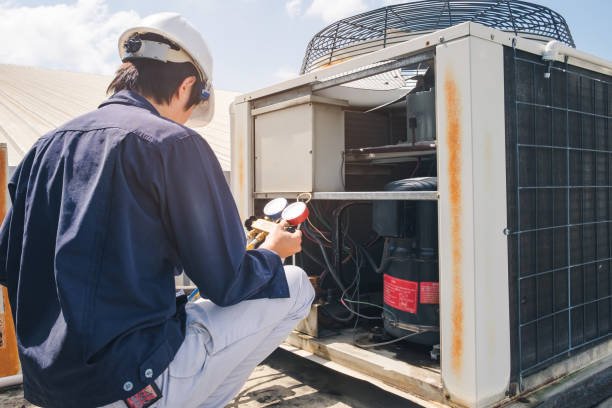As the demand for energy-efficient and environmentally friendly HVAC (Heating, Ventilation, and Air Conditioning) solutions continues to grow, ductless heating and air conditioning systems are becoming a key player in the market. These systems, also known as mini-splits, offer precise climate control without the need for extensive ductwork, making them ideal for both residential and commercial spaces. In recent years, technological advancements have accelerated their adoption, and the future holds even more promise for enhanced efficiency, comfort, and sustainability.
This article explores the future of ductless heating and AC technology, highlighting innovations that will revolutionize the HVAC industry and what homeowners and businesses can expect in the coming years.
1. Energy Efficiency and Smart Integration
One of the most significant trends shaping the future of ductless systems is the push for greater energy efficiency. Ductless systems are already known for their superior energy performance compared to traditional ducted systems, but future models will incorporate even more sophisticated energy-saving technologies. These include:
- Variable Refrigerant Flow (VRF): VRF technology allows for precise control of the refrigerant flow to each indoor unit, adjusting the amount of cooling or heating needed in different zones. This leads to significant energy savings by eliminating the overuse of energy in unoccupied spaces.
- Advanced Inverter Technology: Inverter-driven compressors, which adjust the speed of the compressor motor to match the required heating or cooling load, will become standard. This allows the system to operate at partial loads rather than cycling on and off, reducing energy consumption and extending the life of the system.
- Smart Thermostats and Automation: Future ductless systems will be fully integrated with smart thermostats and home automation platforms. This will allow users to control temperature settings remotely via smartphones, tablets, or voice assistants, ensuring energy is only used when necessary. Advanced sensors and learning algorithms will enable systems to predict user behavior and adjust temperatures automatically, further optimizing efficiency.
2. Improved Environmental Impact
As the world shifts toward greener energy solutions, the HVAC industry is no exception. Ductless systems are already more eco-friendly than their traditional counterparts, but future developments will enhance their environmental credentials even further.
- Low Global Warming Potential (GWP) Refrigerants: One of the biggest environmental concerns with HVAC systems is the refrigerants used. Traditional refrigerants have high GWP, contributing to climate change when leaked. The future will see a transition to low-GWP refrigerants like R-32 and R-454B, which have less environmental impact and comply with stricter regulations.
- Hybrid Heating Solutions: To further reduce reliance on fossil fuels, hybrid heating systems that combine ductless heat pumps with renewable energy sources (such as solar power or geothermal systems) will become more prevalent. These systems will provide heating and cooling that is not only efficient but also sustainable, reducing carbon emissions and energy bills.
- Energy Storage Integration: Innovations in energy storage will also play a key role. Ductless systems in the future may integrate with battery storage solutions, allowing homes to store excess energy during low-demand periods and use it to power HVAC systems during peak times. This not only reduces strain on the grid but also offers homeowners more control over their energy consumption.
3. Enhanced Air Quality and Comfort
The future of ductless heating and AC technology will also focus heavily on improving indoor air quality and occupant comfort. As people spend more time indoors, particularly with the rise of remote work, there is growing demand for systems that provide a healthier and more comfortable environment.
- Integrated Air Purification: Future ductless systems will likely include advanced air purification technologies. UV-C light filters, electrostatic precipitators, and HEPA filters can be integrated into units to remove airborne contaminants, allergens, and pathogens. This ensures that the air being circulated is not only at the right temperature but also clean and safe to breathe.
- Humidity Control: Enhanced humidity control will become a standard feature, helping maintain optimal indoor humidity levels, which is important for both comfort and health. Systems will be able to automatically adjust the level of humidity in a room based on real-time sensor data, preventing conditions that lead to mold growth, dry skin, and other health issues.
- Personalized Comfort Zones: With the rise of zoned heating and cooling, the future will see systems that provide even more personalized control for each room or area of a home or building. Occupants will be able to set different comfort settings for various zones, ensuring everyone’s preferences are met without sacrificing efficiency. This is especially beneficial in commercial spaces, where individual offices or meeting rooms can be climate-controlled independently.
4. Seamless Installation and Design Innovations
The flexibility and ease of installation of ductless systems have always been one of their primary advantages. In the future, these systems will become even more user-friendly and aesthetically adaptable to a variety of spaces.
- Modular Designs: Future ductless systems will be more modular, allowing for easier customization and expansion. Homeowners and businesses will be able to add or remove indoor units as their needs change, without having to overhaul the entire system. This modular approach provides flexibility for growing families, changing floor plans, or expanding commercial spaces.
- Sleeker, Minimalist Units: As interior design trends favor minimalist aesthetics, the design of ductless systems will evolve to match these preferences. Expect to see slimmer, more discreet indoor units that blend seamlessly with walls or ceilings, reducing their visual impact while still providing optimal performance.
- Quicker Installation with Smart Diagnostics: In the future, installation of ductless systems will become even faster and more efficient. Units equipped with smart diagnostics will allow HVAC professionals to troubleshoot and optimize system performance during installation, reducing the time needed for adjustments and ensuring peak efficiency from the start.
5. Increased Adoption of Renewable Energy and Grid Interactivity
As more homes and businesses adopt renewable energy technologies, ductless systems will become more integrated with solar power, wind power, and other renewable energy sources. This trend will not only make heating and cooling more affordable but also more environmentally friendly.
- Grid-Interactive Systems: The future will see more ductless systems integrated with smart grids, allowing them to communicate with utility companies to adjust usage based on demand and electricity rates. During times of high demand, systems could reduce their energy consumption, contributing to grid stability while saving the homeowner money.
- Solar-Powered Systems: Ductless systems paired with solar panels will become more widespread, providing a nearly off-grid solution for heating and cooling. Homeowners will be able to run their HVAC systems using clean energy generated from their own solar installations, further reducing reliance on fossil fuels.
6. AI and Machine Learning for Predictive Maintenance
Artificial intelligence (AI) and machine learning will revolutionize how ductless systems are maintained and serviced. These technologies will enable systems to predict potential issues before they occur, allowing for proactive maintenance and avoiding costly breakdowns.
- Self-Diagnostics: Future ductless systems will be equipped with self-diagnostic tools that constantly monitor performance. These tools can detect when something is wrong, such as a refrigerant leak or airflow issue, and alert the user or service technician before it leads to larger problems.
- Predictive Maintenance Algorithms: AI-driven algorithms will analyze data from the system to predict when maintenance is needed. Instead of waiting for something to go wrong, the system will notify homeowners when it’s time to clean filters, check refrigerant levels, or schedule a professional tune-up. This approach extends the life of the system while ensuring it operates at maximum efficiency year-round.
Conclusion
The future of ductless heating and air conditioning technology promises exciting advancements that will make these systems even more efficient, eco-friendly, and user-friendly. With innovations in energy efficiency, smart integration, improved air quality, and renewable energy adoption, ductless systems will continue to play a pivotal role in the HVAC industry’s evolution. As technology continues to advance, homeowners and businesses can expect enhanced comfort, reduced environmental impact, and long-term cost savings from their ductless systems.
The combination of these technological developments will not only improve the user experience but also contribute to a more sustainable and energy-efficient future.




